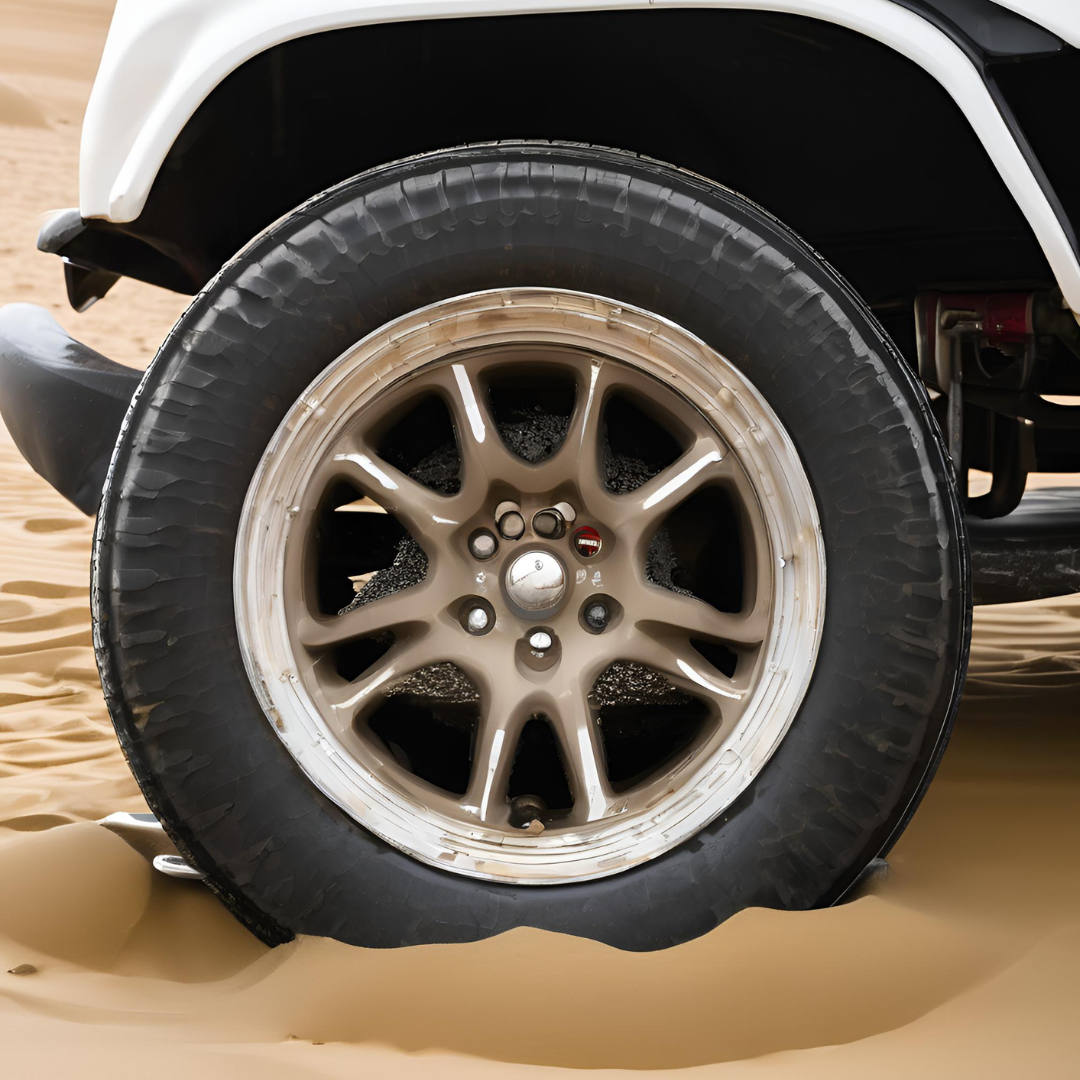
Mastering the Sand: A Comprehensive Guide to 4x4 Driving on Beaches and Dunes
Driving on sand is an exhilarating experience, but it can also be challenging if you're unprepared. To conquer those sandy trails and dunes, you need to understand the fundamentals of sand driving, including proper tyre pressure, the right tyre type, and optimal tyre size. This guide will equip you with the knowledge to confidently navigate sandy terrains, maximize your 4x4's capabilities, and ensure a safe and enjoyable adventure.
The Science Behind Sand Driving
Driving on sand is vastly different from driving on pavement or hard-packed trails. Sand is a loose and shifting surface, creating unique challenges for traction and stability. Here's why:
- Reduced Traction: Sand grains lack the interlocking properties of firmer surfaces, making it difficult for your tyres to grip. This results in reduced traction, making acceleration, braking, and turning more challenging.
- Sinkage and Bogging: The weight of your vehicle can cause it to sink into soft sand, leading to loss of momentum and potentially getting stuck (bogged).
- Tyre Deflection: When driving on sand, your tyres will naturally deflect or "balloon" outwards. This deflection affects the contact patch with the ground and can alter your vehicle's handling characteristics.
The Crucial Role of Tyre Pressure
Lowering your tyre pressure is the most critical step for successful sand driving. Here's why:
- Increased Footprint: Lower tyre pressure allows your tyres to flatten out and expand, increasing the contact patch with the sand. This increased footprint distributes your vehicle's weight over a larger area, reducing ground pressure and minimizing sinkage.
- Improved Traction: A larger contact patch means more of your tyre's tread is engaging with the sand, providing improved traction and grip.
- Smoother Ride: Lower tyre pressure helps your tyres absorb the unevenness of the sand, resulting in a smoother and more comfortable ride.
Finding the Right Pressure:
- Starting Point: A good starting point is 18-20 PSI (pounds per square inch) for most 4x4 vehicles. You can experiment with slightly lower pressures depending on the type of sand and the weight of your vehicle.
- Trial and Error: Experiment with different tyre pressures to find the sweet spot for your vehicle and the specific beach conditions. Start a bit higher (around 18-20 psi) and gradually lower the pressure until you feel optimal traction and floatation on the sand. Remember, every vehicle and tyre setup is different! Even on the same beach, one vehicle might be perfect at 18 psi, while another needs 15 psi, or even as low as 5 psi. Factors like tyre type, vehicle weight, and the specific sand conditions all play a role. (I've personally aired down to 3 psi a few times without any issues. However, it's important to note that I have MT(Mud Tyres) tyres with very stiff sidewalls, which are less likely to pop off the rim at low pressures.)
- Monitor Tyre Temperature: Low tyre pressure can generate more heat. Keep an eye on your tyre temperatures to prevent overheating and potential damage.
- Re-inflate: Don't forget to re-inflate your tyres to their recommended pressure before returning to paved roads.
Choosing the Right Tyre Type
The type of tyre you choose can significantly impact your sand driving experience. Here are some common types and their suitability for sand:
- All-Terrain (AT) Tyres: AT tyres are a good all-rounder option, offering decent performance on both paved roads and off-road trails. While they can handle some sand driving, they may not provide the optimal floatation for deep sand or dunes.
- Mud-Terrain (MT) Tyres: MT tyres are designed for maximum traction in mud and loose terrain. They have aggressive tread patterns with large voids, which can excel in sandy conditions. However, mud-terrain tyres (MT tyres) typically require a greater reduction in air pressure due to their stiffer sidewalls compared to other tyre types. It's worth noting that MT tyres might also be noisier and less comfortable on paved roads.
- Sand Tyres: These specialized tyres are designed for optimal sand driving, but they may not be readily available at all local tyre shops. They have unique paddle-like tread patterns that maximize floatation and traction in soft sand. While they offer superior performance on sand, they are not suitable for other terrains.
Choosing Your Sand Tyres:
Consider these factors when selecting sand tyres:
- Tread Pattern: Look for aggressive tread patterns with large voids or paddles that can scoop and propel through sand.
- Tyre Size: Larger tyres generally offer better floatation in sand. Consult your vehicle's manual and local regulations for appropriate tyre sizes.
- Tyre Construction: Radial tyres are generally recommended for sand driving due to their flexibility and ability to conform to the terrain.
Tyre Size: Striking the Right Balance
The size of your tyres also plays a crucial role in sand driving performance. Here's what you need to consider:
- Width: Wider tyres provide a larger footprint, improving floatation and traction. However, overly wide tyres can make steering more difficult.
- Diameter: Taller tyres offer better ground clearance, preventing your vehicle from bottoming out in deep sand. They also provide a larger contact patch.
- Sidewall Height: Taller sidewalls allow for more tyre deflection, improving traction and ride comfort.
Optimal Tyre Size for Sand:
- General Recommendation: A good starting point is 32–33-inch diameter tyres with a width of 10-12 inches (255-305 mm).
- Vehicle Weight: Lighter vehicles may require slightly smaller tyres, while heavier vehicles may benefit from larger tyres.
- Personal Preference: Ultimately, the best tyre size for you depends on your personal preference, driving style, and the specific conditions you'll encounter.
Maximizing Momentum: How Disabling Traction Control Helps in Sand
In sandy conditions, disabling traction control can improve your vehicle's performance. Traction control systems are designed to prevent wheel spin on slippery surfaces like ice or wet roads. However, in sand, some wheel spin is necessary to maintain momentum and "float" over the surface. When traction control is engaged, it often detects this necessary wheel spin as a loss of traction and applies brakes to the spinning wheel, cutting power and hindering your progress. By disabling traction control, you allow the wheels to spin freely, giving you better control over your vehicle's momentum and increasing your chances of successfully navigating sandy terrain.
Additional Tips for Driving on Sand
- Momentum is Key: Maintain momentum to avoid getting bogged down in soft sand. Avoid sudden acceleration or braking.
- Steering Technique: Use smooth and controlled steering inputs. Avoid jerky movements or sharp turns.
- Use 4WD: Engage 4WD (four-wheel drive) for optimal traction and control.
- Air Down Gradually: Lower your tyre pressure gradually to avoid damaging your tyres or wheels.
- Carry Recovery Gear: Always carry recovery gear such as a shovel, recovery boards (Maxtrax), and a tow strap in case you get stuck.
Conclusion:
By understanding the nuances of sand driving and implementing the tips in this guide, you'll be well-equipped to tackle challenging terrains and create unforgettable memories in the sand. Remember, preparation and knowledge are key to a successful and enjoyable adventure. So, air down your tyres, choose the right gear, and let the adventure begin!
